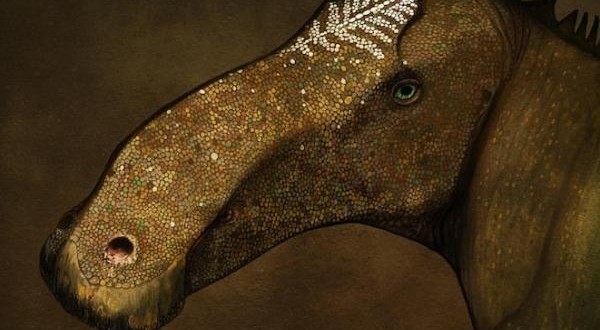Scientists at Montana State University have identified a new duck-billed dinosaur species dubbed “Superduck.” Its scientific name is Probrachylophosaurus bergei, according to a paper published today in the journal PLOS ONE.
The paper was written by that professor, Elizabeth Freedman Fowler, and her mentor, MSU paleontologist Jack Horner, Montana University System Regents Professor and curator of paleontology at MSU’s Museum of the Rockies. Their findings highlight how the new species of duckbilled dinosaur neatly fills a gap that had existed between an ancestral form with no crest and a descendant with a larger crest, providing key insight into the evolution of elaborate display structures in these gigantic extinct herbivores.
“It is really gratifying to see Dr. Freedman Fowler’s work, which is essentially her dissertation, published in PLOS ONE,” Horner said. “It is confirmation that she is an excellent paleontologist, helping further cement MSU’s reputation for offering graduate students a chance to be part of something extraordinary.”
In their paper, Freedman Fowler and Horner named the dinosaur Probrachylophosaurus bergei and suggest it is a previously missing link between a preceding species, Acristavus, which lived about 81 million years ago, and later form Brachylophosaurus, which lived about 77.5 million years ago.
“The crest of Probrachylophosaurus is small and triangular, and would have only poked up a little bit on the top of the head, above the eyes,” said Freedman Fowler, who received her doctorate in paleontology from MSU’s Earth Sciences Department in 2015. She also serves as curator of paleontology at the Great Plains Dinosaur Museum in Malta.
The other bones in its skull are very similar to those of Acristavus and Brachylophosaurus, Freedman Fowler said. However, Acristavus does not have a crest; the top of its skull is flat, while Brachylophosaurus has a large flat paddle-shaped crest that completely covers the back of the top of its skull.
“Probrachylophosaurus is therefore exciting because its age – 79 million years ago – is in between Acristavus and Brachylophosaurus, so we would predict that its skull and crest would be intermediate between these species. And it is,” Freedman Fowler said. “It is a perfect example of evolution within a single lineage of dinosaurs over millions of years.”
During the summer of 2007, Freedman Fowler was leading a crew from the Museum of the Rockies in excavating a bed of earth near the town of Rudyard in north central Montana. The site contained fossils of duckbilled dinosaurs. A visiting school group discovered bones poking out of an old quarry originally worked by a group from the University of California Berkeley in 1981.
Horner recognized that some of the new bones were parts of a skull, which is the most crucial part of the skeleton for identifying the species. Hopeful that more of the skull might be found, he asked Freedman Fowler to switch her crew over to the old Berkeley quarry to see what else might emerge.
“The first bones we uncovered were the pelvis and parts of the legs; which were so large it led to the site being given the nickname ‘Superduck,’” Freedman Fowler said.
After returning to the lab to clean and identify everything the crew had collected, Freedman Fowler and Horner discovered they had most of the skull and postcranium of a new kind of dinosaur.
A nearby site also revealed a fragmentary juvenile of the transitional Probrachylophosaurus, which suggests that successive generations of the Brachylophosaurus lineage grew larger crests by changing the timing or pace of crest development during growth into adulthood. This change in the timing or rate of development is called heterochrony, a process which is being increasingly recognized as a major driving force in evolution.
“Heterochrony is key to understanding how evolution actually occurs in these dinosaurs, but to study heterochrony we need large collections of dinosaurs with multiple growth stages, and a really precise time framework for the rock formations that we collect them from,” said Freedman Fowler.
It is research that has become increasingly possible with recent technical advances in the radiometric dating of rocks coupled with increased intensity of fossil collecting in North America, she added.
“The Late Cretaceous of western North America is the only place in the world where we can do these kinds of intense paleobiological studies on dinosaurs,” Freedman Fowler said. “Nowhere else combines the precise dating of rocks coupled with an exceptional fossil record that has been so extensively collected.”
Horner agreed, adding that he’d begun digging fossils in this particular location at the beginning of his career.
“It is really exciting to see that we are still making significant discoveries there,” Horner said. “And it’s great to see our graduate students taking the lead in pushing for even more.”
Agencies/Canadajournal
 Canada Journal – News of the World Articles and videos to bring you the biggest Canadian news stories from across the country every day
Canada Journal – News of the World Articles and videos to bring you the biggest Canadian news stories from across the country every day



